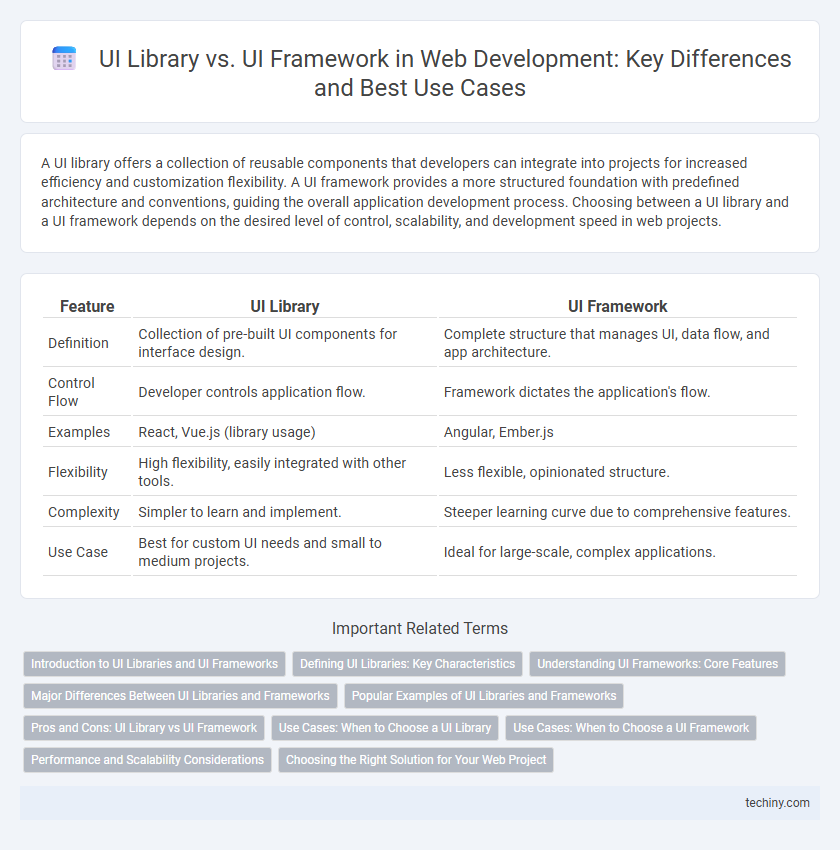A UI library offers a collection of reusable components that developers can integrate into projects for increased efficiency and customization flexibility. A UI framework provides a more structured foundation with predefined architecture and conventions, guiding the overall application development process. Choosing between a UI library and a UI framework depends on the desired level of control, scalability, and development speed in web projects.
Table of Comparison
| Feature | UI Library | UI Framework |
|---|---|---|
| Definition | Collection of pre-built UI components for interface design. | Complete structure that manages UI, data flow, and app architecture. |
| Control Flow | Developer controls application flow. | Framework dictates the application's flow. |
| Examples | React, Vue.js (library usage) | Angular, Ember.js |
| Flexibility | High flexibility, easily integrated with other tools. | Less flexible, opinionated structure. |
| Complexity | Simpler to learn and implement. | Steeper learning curve due to comprehensive features. |
| Use Case | Best for custom UI needs and small to medium projects. | Ideal for large-scale, complex applications. |
Introduction to UI Libraries and UI Frameworks
UI libraries like React and Vue provide pre-built components and utilities that help developers build user interfaces efficiently by focusing on the view layer, offering flexibility in integration. In contrast, UI frameworks such as Angular or Ember deliver a comprehensive solution that includes built-in tools for routing, state management, and data handling, enforcing a specific architecture and development workflow. Choosing between a UI library and a UI framework depends on project complexity, development speed, and the desired level of control over application structure.
Defining UI Libraries: Key Characteristics
UI libraries in web development provide a collection of pre-built, reusable components that streamline the design process without enforcing strict project structures, offering flexibility in integration and customization. Key characteristics include modularity, allowing developers to selectively implement components, and a focus on specific UI elements like buttons or grids, rather than full application architecture. Unlike frameworks, UI libraries emphasize control over UI design while requiring developers to manage application flow and state independently.
Understanding UI Frameworks: Core Features
UI frameworks provide a comprehensive set of tools including pre-built components, standardized design patterns, and built-in state management, enabling developers to build complex applications efficiently. They enforce a structured architecture and often include routing, data handling, and testing utilities, ensuring consistency and scalability across projects. Core features of UI frameworks like Angular, React (when used as a framework with additional libraries), and Vue emphasize modularity, reusability, and integration capabilities that streamline the development workflow.
Major Differences Between UI Libraries and Frameworks
UI libraries like React provide pre-built components that developers can integrate selectively, offering flexibility in building user interfaces. UI frameworks such as Angular enforce a structured architecture and comprehensive toolset, guiding the application's entire development process. The major difference lies in control flow: libraries allow developers to call functions as needed, while frameworks dictate the flow by invoking developer code within their lifecycle.
Popular Examples of UI Libraries and Frameworks
Popular UI libraries such as React, Vue.js, and Angular emphasize reusable components and flexibility, enabling developers to build dynamic user interfaces efficiently. UI frameworks like Bootstrap and Foundation offer comprehensive design systems with predefined styles and layout grids that accelerate responsive web development. Choosing between a UI library or framework depends on project needs, where libraries provide component-level control and frameworks deliver full-featured architectural solutions.
Pros and Cons: UI Library vs UI Framework
UI libraries offer reusable components and flexibility, allowing developers to integrate specific features without enforcing architectural constraints, which speeds up development and customization. UI frameworks provide comprehensive structure and standardized conventions, promoting consistency and maintainability across large applications, but can introduce a steeper learning curve and limit flexibility. Choosing between them depends on project size, complexity, and the desired level of control versus guidance in the development process.
Use Cases: When to Choose a UI Library
A UI library is ideal when developers need to integrate specific components into an existing project without restructuring the entire codebase, allowing for greater flexibility and control over the application's architecture. It suits scenarios where customization and lightweight performance are priorities, such as enhancing a single page with interactive elements or building unique design systems. Choosing a UI library is effective when the goal is to complement a custom framework or a backend-driven application, rather than adopting a complete development paradigm.
Use Cases: When to Choose a UI Framework
UI frameworks are best suited for complex applications requiring a structured architecture, integrated state management, and built-in routing capabilities. They provide a comprehensive solution for scalable projects demanding consistent design patterns and extensive functionality beyond just visual components. Teams working on large-scale enterprise applications or progressive web apps benefit most from frameworks like Angular or React combined with state libraries.
Performance and Scalability Considerations
UI libraries offer focused, lightweight components that enhance performance by allowing developers to selectively integrate features, resulting in faster load times and optimized rendering. UI frameworks provide a comprehensive structure that promotes scalability through consistent patterns and built-in state management, which supports complex application growth with maintainable codebases. Choosing between a UI library and a UI framework depends on project requirements, balancing the need for performance efficiency with scalable architecture.
Choosing the Right Solution for Your Web Project
Selecting between a UI library and a UI framework depends on your project's scale, flexibility needs, and development speed. UI libraries like React offer modular components for customizable interfaces, while frameworks such as Angular provide comprehensive toolsets and built-in functionalities that streamline complex application development. Understanding the trade-offs in control and abstraction helps developers align their choice with project requirements and long-term maintenance strategies.
UI library vs UI framework Infographic

 techiny.com
techiny.com